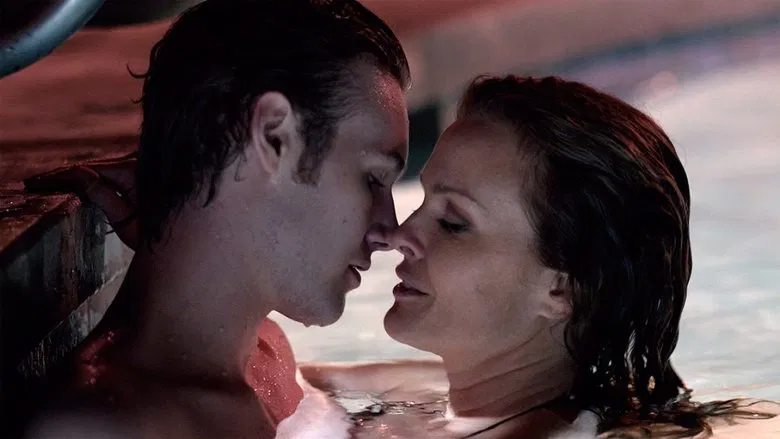Lethal Seduction (2015)

Exploring Lethal Seduction (2015): A Taut Lifetime Thriller
Lethal Seduction (2015), also known as Stripped of Innocence, is a gripping made-for-TV thriller that aired on the Lifetime network on July 11, 2015. Directed by Nancy Leopardi, this 80-minute film dives into the dark side of desire, weaving a tale of manipulation, obsession, and familial bonds tested by a predatory femme fatale. Starring Caleb Ruminer, Amanda Detmer, and Dina Meyer, the movie delivers a provocative mix of suspense, psychological drama, and risqué content tailored to Lifetime’s signature style. While it leans into familiar tropes of the “cougar fatal attraction” subgenre, Lethal Seduction stands out for its intense performances and cautionary narrative about the dangers of unchecked desire. This comprehensive article explores the film’s plot, production, themes, cultural impact, and why it remains a compelling watch for fans of Lifetime thrillers.

Synopsis: A Dangerous Affair
Lethal Seduction centers on Mark Richards (Caleb Ruminer), an 18-year-old high school senior preparing to leave for Princeton in the fall. A dutiful son to his overprotective widowed mother, Tanya Richards (Amanda Detmer), Mark leads a relatively sheltered life in a suburban setting. His world shifts when he encounters Carissa Kensington (Dina Meyer), a seductive, middle-aged widow who lives next door. Their chance meeting at a hardware store—where Carissa enlists Mark’s help to install a showerhead—sparks a passionate affair that quickly spirals into something far more sinister.
Carissa’s charm and sexual allure draw Mark into her luxurious, hedonistic world, but her manipulative nature soon surfaces. She pressures Mark to prioritize her over his family, demanding he cut ties with Tanya and even encouraging dangerous behavior. Tanya, sensing changes in her son, uncovers unsettling details about Carissa’s past, including the mysterious death of her ex-husband. As Tanya fights to protect Mark, Carissa’s obsession escalates, leading to violent confrontations and a chilling showdown. The film weaves in symbolic imagery, such as sharks in an aquarium, to underscore Carissa’s predatory nature, culminating in a tense battle of wills between a protective mother and a dangerous seductress.

The Making of Lethal Seduction
Development and Direction
Directed by Nancy Leopardi, known for producing Lifetime films, Lethal Seduction was crafted as a quintessential network thriller, blending soap opera drama with psychological suspense. The screenplay, written by Roger Stigliano and Michael Waite, leans heavily into the “older woman, younger man” trope, drawing inspiration from classics like Fatal Attraction (1987) but tailored for Lifetime’s audience. Produced by MarVista Entertainment, the film was shot on a modest budget, typical of made-for-TV movies, with filming taking place in Los Angeles to capture a generic suburban backdrop.
Leopardi’s direction emphasizes character dynamics over flashy visuals, focusing on the escalating tension between Mark, Tanya, and Carissa. The film’s pacing is brisk, with a runtime of 80 minutes, ensuring the narrative remains engaging despite its predictable beats. Artistic touches, such as intercut scenes of sharks in an aquarium where Tanya’s boyfriend Randy (Brian Smith) works, add a layer of symbolism, portraying Carissa as a predatory force circling her prey.
Casting and Performances
The casting of Lethal Seduction is one of its strongest assets. Caleb Ruminer, a relative newcomer at the time, brings a believable naivety to Mark, capturing the vulnerability of a young man swept up by an older woman’s charisma. Amanda Detmer shines as Tanya, portraying a mother whose protectiveness evolves into fierce determination as she confronts Carissa’s threat. Dina Meyer steals the show as Carissa Kensington, embodying the role of a psychotic femme fatale with a mix of allure and menace. Meyer’s performance, lauded for its intensity, draws on her experience in films like Starship Troopers (1997), making her a standout as the manipulative widow.
The supporting cast, including Brian Smith as Randy, Sam Lerner as Mark’s friend Walter, and Tessa Harnetiaux as Melanie, a classmate Mark briefly dates, adds depth to the story. While some secondary characters, like the underused Randy, feel underdeveloped, the core trio’s chemistry drives the narrative, particularly in the heated confrontations between Tanya and Carissa.

Technical Aspects
Lethal Seduction employs straightforward cinematography, with clean, functional visuals that prioritize the story over stylistic flourishes. The film’s suburban settings—hardware stores, modern homes, and a pool party—create a relatable backdrop that contrasts with Carissa’s dangerous influence. Key scenes, such as Mark and Carissa’s encounters in her pool or a sauna, are shot with a focus on sensuality, pushing the boundaries of TV-14 content with suggestive imagery and high “sex quotient” for a Lifetime film.
The sound design enhances the tension, with a subtle score that underscores the film’s darker moments. The aquarium scenes, featuring sharks named to reflect Carissa’s predatory nature, are a clever touch, though some critics noted the editing feels choppy, particularly in transitions between Mark’s affair and his mother’s investigation. Despite these flaws, the film’s technical execution serves its purpose, delivering a polished, if formulaic, thriller.

Themes and Symbolism
Lethal Seduction explores themes of obsession, manipulation, and the clash between maternal love and destructive desire, using its thriller framework to deliver a cautionary tale.
Obsession and Manipulation
Carissa’s character embodies the archetype of the obsessive seductress, using her sexuality as a weapon to control Mark. Her attempts to isolate him from his mother and friends highlight the dangers of manipulative relationships, particularly those exploiting power imbalances. The film portrays Carissa as both alluring and unhinged, with her violent actions—such as attacking Melanie with a knife—revealing her descent into madness.
Maternal Protection vs. Predatory Desire
The central conflict between Tanya and Carissa represents a battle between protective love and predatory obsession. Tanya’s overprotective nature, while initially portrayed as smothering, becomes her strength as she fights to save Mark. The film contrasts her selfless devotion with Carissa’s selfish manipulation, emphasizing the power of familial bonds over toxic relationships.

Youth and Vulnerability
Mark’s naivety as an 18-year-old on the cusp of adulthood underscores the vulnerability of youth to predatory influences. His initial infatuation with Carissa reflects a common coming-of-age struggle, but the film warns of the consequences when such desires are exploited by someone with ulterior motives. The aquarium imagery, with sharks circling, symbolizes the dangers lurking in the “real world” Mark is about to enter.
Power Dynamics and Gender
Directed by a female filmmaker, Lethal Seduction offers a gendered perspective on power dynamics, with Carissa wielding her sexuality to dominate Mark. Some reviews highlight this as a commentary on the “irresistible power” of a woman’s allure, though critics argue the film’s male-written script leans into stereotypes, portraying Carissa as a one-dimensional villain. The film’s exploration of gender is complex, balancing empowerment with cautionary undertones about manipulation.
Cultural Impact and Reception
Lethal Seduction premiered on Lifetime on July 11, 2015, fitting squarely into the network’s lineup of sensational thrillers. It received mixed reviews, with a 4.9/10 rating on IMDb and no Rotten Tomatoes score due to limited critic reviews. Audiences appreciated its entertainment value, with comments praising its “almost laugh out loud” dialogue and Meyer’s captivating performance as the “crazy lady.” However, critics like Richard Roeper and Ben Kenigsberg dismissed it as a formulaic Lifetime movie, noting its lack of originality and reliance on campy tropes.
The film’s high sexual content, including scenes of Mark handcuffed in his boxers and suggestive encounters, pushed boundaries for Lifetime’s TV-14 rating, drawing both praise for its boldness and criticism for its gratuitousness. Its niche appeal lies in its campy, soapy drama, making it a guilty pleasure for fans of Lifetime’s brand of thrillers. The film’s cultural impact is modest, but it remains a notable entry in the “seductive villainess” subgenre, with Carissa Kensington earning a spot on fan wikis like The Female Villains Wiki for her psychotic femme fatale persona.
Lethal Seduction reflects Lifetime’s mid-2010s focus on provocative, female-driven narratives, akin to films like A Deadly Adoption (2015). While it didn’t break new ground, its blend of suspense and melodrama ensures it resonates with viewers seeking escapist thrills.

Why Lethal Seduction Stands Out
Lethal Seduction excels as a quintessential Lifetime thriller, delivering exactly what fans expect: a mix of scandal, suspense, and over-the-top drama. Dina Meyer’s magnetic performance as Carissa elevates the film, making her both seductive and terrifying in a way that keeps viewers hooked. The dynamic between the three leads—Ruminer’s naive Mark, Detmer’s protective Tanya, and Meyer’s unhinged Carissa—creates a compelling triangle of conflict, even if the script leans on familiar tropes.
The film’s pacing and short runtime make it an accessible watch, while its risqué content and shark symbolism add a layer of intrigue. For those who enjoy campy, melodramatic thrillers, Lethal Seduction delivers with its catty confrontations and shocking twists, like Carissa’s attack on Melanie. It’s not a cinematic masterpiece, but its entertainment value and Meyer’s standout performance make it a memorable addition to the Lifetime catalog.

Where to Watch
Lethal Seduction is available on streaming platforms like Amazon Prime Video, Hoopla, and Plex, with options to rent or buy on Prime Video, YouTube, Fandango at Home, and Apple TV. Check JustWatch for current streaming availability in your region. The film’s 80-minute runtime and TV-14 rating make it an easy, engaging watch for a cozy night in.
Conclusion
Lethal Seduction (2015) is a taut, provocative thriller that captures the essence of Lifetime’s brand of melodrama. Directed by Nancy Leopardi and anchored by stellar performances from Caleb Ruminer, Amanda Detmer, and especially Dina Meyer, the film spins a cautionary tale of obsession and manipulation with just enough camp to keep it entertaining. While it doesn’t reinvent the genre, its intense character dynamics, suggestive content, and symbolic flourishes make it a standout for fans of made-for-TV thrillers. Whether you’re drawn to the psychological tension, the scandalous affair, or Carissa’s shark-like menace, Lethal Seduction offers a wild ride through a world where desire can turn deadly. Dive in and brace yourself for a thrilling, if predictable, battle of wills.
